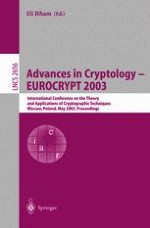2003 | Buch
Advances in Cryptology — EUROCRYPT 2003
International Conference on the Theory and Applications of Cryptographic Techniques, Warsaw, Poland, May 4–8, 2003 Proceedings
herausgegeben von: Eli Biham
Verlag: Springer Berlin Heidelberg
Buchreihe : Lecture Notes in Computer Science
Enthalten in: Professional Book Archive
